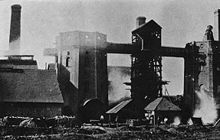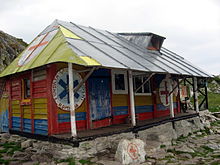Retezat Mountains
p5
The Retezat Mountains (Roman. Munții Retezat, Hungarian. Retyezát-hegység) is the main mountain range of the Retezat-Godeanu Group, the westernmost part of the Southern Carpathians in Romania. Important parts of the mountain are under protection: it was declared the first Romanian national park in 1935, which (along with Pirin and the Tatra National Parks in Poland and Slovakia, for example) is one of the most important high mountain nature reserves in Europe outside the Alps.
The Retezat National Park is located in the west of the massif, in the centre of the mountain range, from a sea level of 794 m to the highest point of the range, Peleaga peak at 2509 m. Another 19 peaks reach heights of over 2000 m, e.g. Păpușa (2508 m), Retezat (2482 m), Vârful Mare (2463 m), Custura (2457 m) and Bucura (2433 m). Lacul Bucura, in the centre of the massif, is the largest natural lake in the Romanian Carpathians.
The area belongs to the county of Hunedoara and thus still to the inner Romanian Transylvania (Transylvania). The surrounding valleys form a sharp contrast to the mountains, which are still characterized by very traditional mountain agriculture, as they are predominantly occupied by heavy industry. The region is a center of Romanian coal mining. About 60 percent of the professional population works in the coal mines. Petroșani (Engl. Petroschen - formerly also Steinthal), to the east at the bifurcation of the valleys, is even partly called the city of coal. These coal deposits have long been known and in use (1788 - see Vulcan). The coal is partly exploited in the surroundings of the Retezat Mountains - for instance in Vulcan (Wolkersdorf), Uricani or north of the mountains in Călan.
Geography
The Retezat Mountains form the central massif of the western end of the Southern Carpathians, a final alpine high point from which the mountains slope down to the west and southwest. Towards the east it is separated by a deep incision from the central part of the Southern Carpathians, the Șureanu-Parâng-Lotrului mountain group. Specifically, it is separated from the Munții Șureanu by the valley of the Strei (Strell) to the northeast and from the Munții Parâng by the valley of the Jiu (Schil) to the far east. These valleys form one of the three great breakthroughs or crossings of the Southern Carpathians between Transylvania and Wallachia. To the south, one enters Little Wallachia.
In the south, the valley of Lupeni (pronounced Lupèn), which runs in a west-east direction and drains the Retezat-Godeanu group centrally to the east, divides this mountain group - and the Retezat Mountains from the Munții Vâlcan to the south. This valley branches off to the west from the Valea Jiului (Schiltal) at Petroșani. It is the valley of the western Jiu spring river, Jiul de Vest, which joins there with the eastern tributary - Jiul de Est, which rises between the Șurean and Parâng mountains.
Mountains with more than 2000 m altitude
|
|
Geology
The main massif consists of crystalline schist and granite diorite. Only the so-called "Small Retezat" is a karst massif consisting of limestone.

The Retezat Mountains from Peleaga, with indication of some landmarks
Tourism
The Retezat Mountains are - in terms of the national park - well developed for tourism, which is evident from the numerous, well-marked hiking trails and the established campsites. Wild camping is prohibited. The paths are partly quite difficult to walk on, as they often only consist of rough boulders.
Camping Opportunities:
- Cabana Pietrele: located in the northern part, many mosquitoes, muddy, makes an overall unkempt impression.
- Lacul Bucura (directly on the lake): magnificent view of the mountain panorama (Bucura, Peleaga, Judele). It can get crowded there, as there is not too much space for the usually high number of visitors.
- Poiana Pelegii: a lot of space, situated in the valley, directly at a small brook.
- La Fete, near Cabana Buta: located directly at the creek; there are some good camping possibilities.

Blast furnace in Kalan (Călan) 1896

Cottage at Lake Bucura
Questions and Answers
Q: What are the Retezat Mountains?
A: The Retezat Mountains are one of the highest massifs in Romania and part of the Southern Carpathians.
Q: What is the highest peak in the Retezat Mountains?
A: The highest peak in the Retezat Mountains is Peleaga (Vârful Peleaga), at an altitude of 2,509 meters (8,232 feet).
Q: What are some other important peaks in the Retezat Mountains?
A: Other important peaks in the Retezat Mountains are Păpuşa (Varful Păpuşa) and Retezat Peak (Vârful Retezat).
Q: What are some features of the Retezat Mountains?
A: The Retezat Mountains have many glacial lakes, and the largest glacial lake in Romania, Bucura Lake (lacul Bucura), is located in these mountains. The area also contains Romania's first national park, the Retezat National Park.
Q: Where is Bucura Lake located?
A: Bucura Lake is located in the Retezat Mountains, at an altitude of 2,030 meters (6,660 feet) above sea level.
Q: What is the size of Bucura Lake?
A: Bucura Lake covers 8.9 hectares (22.0 acres).
Q: What is the Retezat National Park?
A: The Retezat National Park is Romania's first national park and is located in the Retezat Mountains.
Search within the encyclopedia